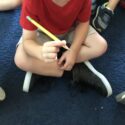Teamwork Activities For Kindergarten
Preschool and kindergarten provide some of the first social experiences that children receive and it was initially designed to support children in growing and developing these interpersonal skills. But today, with all the academic demands coming down on us, we might easily overlook teamwork activities and hope that children develop these and other social skills on their own.

But if you take a moment and think of all of the ways in which you work together with others in your adult life, you can easily see how important it is for us to give it some attention and support children in developing this strength.
Here are some teamwork activities and ideas that I’ve used with my own kinders to help them work better together.
Establishing Table Teams
Each of our tables is considered a “team,” and the children that sit there together are called teammates.
Here’s how they work!
Each table has a team name that we co-created, based on a current interest or inquiry. (i.e. sun, moon, Earth) Each team is encouraged to use table manners and good work habits while working at these tables.


Table manner sticks (craft sticks) are awarded to positively reinforce these behaviors.
At the end of the week, we count these sticks and the team with the most sticks becomes the VIP table for the following week. They get to keep a trophy (balloon weight) at their table and are always called first to line up.

Since there are times when one or two of the members are not showing good table manners/work habits, we talk about what they can do to help everyone be a good team player (ie. remind them, help them, etc.)
Reading About Teamwork in Books
Teamwork is a common theme in many children’s books including those categorized as “pulling stories,” such as The Enormous Potato, The Gigantic Turnip, The Enormous Carrot, and Big Pumpkin. The children love these outrageous books that show characters working toward a common goal and they illustrate well how everybody’s contribution matters. They are also great for retelling and illustrating a plus one, staircase pattern in math.

Exploring Teamwork in the Natural World
Some of the best examples of teamwork show up in nature! Watch this video, Why Do Animals Team Up in Nature? to learn how many different animals live and work together. And this video, showing ants working together to build a bridge, was a big hit with my kiddos!
In addition to ants, learning about the social nature of bees is also a great example of teamwork.

I shared these objects and asked kids if any of them were good examples of animal teamwork. Then, we discussed how wax, honey, and the wasp nest were all the result of cooperative efforts.

Posing Team Challenges
Kids love a challenge, but it’s through these experiences that they realize that it isn’t always easy to work as a team.
I challenged table teams to untie the human knot, (you can find the directions on the video),

work together to do a puzzle,

and assemble a red collage using objects found around the classroom.

Most of the teams did an amazing job working together. But some had difficulty, mostly due to a few children “taking over” and not including everyone in the work. In talking about this, I was able to point out that while the goal was important, the people are always more important!
Teamwork Activities Through Choice Time
In addition to establishing table teams, reading about teamwork, exploring teamwork in the natural world, and posing challenges, children need regular opportunities, in natural settings, to experience working together and solving conflicts through play.
To do this, I regularly offer choice time centers, where children work together to build towers, tell stories, sort math shapes, make pictures, and more.

As they do, they naturally encounter problems and are challenged with using creativity and critical thinking to figure out ways to solve them. I teach into these “problems,” either on the spot or during a mini lesson or morning meeting.
And while all of the above ideas can lead to better teamwork skills, it’s through choice time centers that I find the richest opportunities for growing their abilities to work together.
Building Community Beyond Teamwork Activities
Fostering teamwork, is just one element of building community and creating a more student-centered classroom. To read more about other elements, check out the Student-Centered Classroom Toolkit, where you will find practical ways to support children in becoming more active and engaged participants in your classroom environment.
It includes one section on forming teams and partnerships along with ideas on negotiating curriculum, igniting student voices, sparking curiosity, fostering self-regulation and much more.
And download this FREE Community Building Toolkit for more to ideas on how to build classroom community.
This post contains affiliate links. Roots & Wings is a participant in the Amazon Services LLC Associates Program, an affiliate advertising program designed to provide a means for sites to earn advertising fees by advertising and linking to Amazon.com.





 Positivity Project: Curiosity
Positivity Project: Curiosity Christmas Kindness Countdown Calendar
Christmas Kindness Countdown Calendar 6 Building Blocks to Launch Your First Weeks of Kindergarten
6 Building Blocks to Launch Your First Weeks of Kindergarten Teaching Children to Say Thank You
Teaching Children to Say Thank You
kreş oyuncakları kreş donanımları creche toys montessori oyuncakları okul öncesi eğitici oyuncaklar eğitici oyunlar ahşap oyuncaklar keçe oyuncaklar oyun evleri okul anaokulu ve kreş okul donanımları okul öncesi eğitim araçları masa ve sıralar akıllı tahtalar kız oyuncakları galoşluk dolaplar kitaplıklar soft play ürünler premium serisi mobilyalar ilgi köşeleri sepete ekle tıkla yengeç eğitim araçları anaokulu mobilyaları anaokulu donanımları kreş malzemeleri kreş oyuncakları https://www.yengecegitim.com/kres-oyuncaklari-isleri